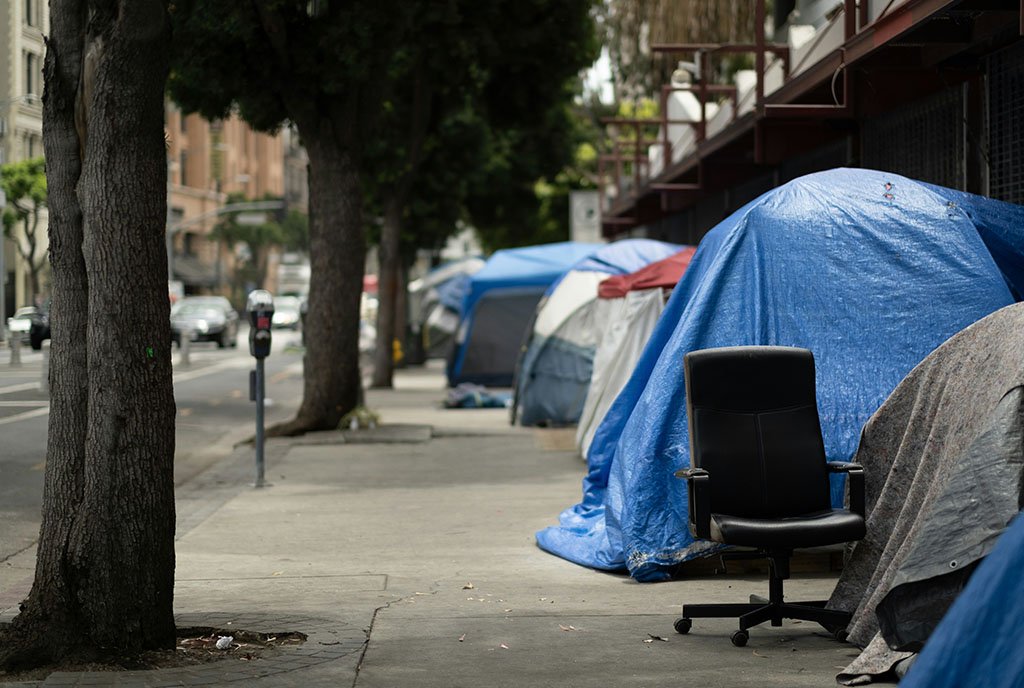
Detrese Dowridge has been organizing tenants in Baltimore, Maryland, since she herself had to face down her landlord, Sage Management, in 2014. “I always knew there was something going on. I just couldn’t put my finger on it,” Dowridge explains. “I was working with temp agencies where my hours would fluctuate, so I was sometimes late on my rent, but I would eventually get paid.” But when she would pay the amount due on the court notice, Sage Management would send another notice demanding additional payments. Dowridge was skeptical. To add insult to injury, she was being forced to pay extra for a unit that was shoddy. “I was having issues with the rodents, with the roaches…it was horrible.”
Around this time, Baltimore tenant organizing group Right to Housing Alliance (RTHA) knocked on Dowridge’s door. “They were trying to identify certain property managers who always had court dates and filed a lot,” Dowridge says. “I took it upon myself to go to one of their meetings to see what it was about.” Soon after, Dowridge faced down retaliation and multiple eviction filings with the robust support of RTHA members. Dowridge recalls, with a proud smile across her face, that “[RTHA] would sit in the court with tenants, and when my case was called, everyone stood up with me.”
With RTHA and legal support from the local organization, Public Justice Center, Dowridge became a plaintiff in a class action lawsuit against Sage Management. The suit alleged that the company had engaged in the illegal practice of “fee churning,” wherein tenants late on rent were charged with illegal agent, court, and eviction fees. In May 2015, plaintiffs received a $1 million settlement.
Dowridge has spent the following seven years organizing with RTHA, becoming its president in 2018. This year, RTHA merged with Baltimore Renters United (BRU), a local advocacy coalition that formed in 2017 and is currently pivoting into a city-wide, tenant-led organizing effort. (Full disclosure: I am a member of their steering committee). This pivot was driven in large part by a clear need for a space where renters, like those who have been seeking RTHA’s help for years, could share their stories, get support, and, most importantly, build power.
The Local Context
According to the 2020 US census, 62.3 percent of Baltimore residents are Black. Baltimore is a highly segregated city where eviction rates for Black households are three times the rates for white households; the eviction rate for Black woman-headed households is nearly four times the rate for white man-headed households. Back in 2015, writing for The Atlantic, Eva Rosen noted that in Baltimore, “nearly all of the high-rise public housing was torn down in the 90s,” and “one in five households lives under the federal poverty line.” A 2016 report on Baltimore’s housing affordability, published by the Abell Foundation, found that nearly 60 percent of renters pay more than 30 percent of their income on housing, while 33 percent pay more than half.
Baltimore is also a city where private corporate landlords have bought up more and more property. As Alexander Ferrer pointed out last year in The Atlantic, “corporate landlords are notorious for squeezing renters in every imaginable way—and for setting up byzantine ownership and management structures that frustrate anyone who might complain.” Federal Reserve data from Atlanta confirms that corporate landlords are far more likely to evict their tenants.
Winning Against a Corporate Landlord
It is in this context that Detrese and BRU find themselves in deep community with a rapidly growing network of new tenant-led organizing efforts. The Lanvale Court Apartments’ tenants union, for example, was established in 2018 and has 10 active members. Even with this modest membership, the group has logged significant victories. It began around the time that Lanvale Apartments was acquired by Lanvale Court LLC. Tenants traced this entity back to Lincoln Avenue Capital LLC, a company based in Santa Monica, California, that hired Winn Company to manage the property.
Under Lincoln’s ownership, Lanvale tenants were subjected to awful living conditions that damaged their physical and mental health. Multiple tenants have recounted harrowing experiences with black mold, leaks, malfunctioning fire alarms, broken elevators, cloudy tap water, and ongoing issues with heating in the dead of winter. When residents filed requests with Winn Company’s management, responses ranged from total disregard to threats of eviction.
One of the main tenant organizers, Marty Wilson, helped escalate the group’s organizing in 2021, and with support from the Greater Baltimore chapter of the Democratic Socialists of America and BRU, the group organized rent escrow clinics, cookouts, know-your-rights canvasses, press conferences, and tenant meetings. The union’s campaign culminated in a December 2021 protest in front of the Baltimore Department of Housing and Community Development (DHCD), drawing the city’s attention to the fact that Lanvale tenants had not had heat or hot water for weeks.
During the protest, Wilson described his dire circumstances to reporters. “I haven’t had heat for about a year and a half,” he said.
Lincoln Avenue Capital LLC has since sold the property. Conditions at Lanvale have improved dramatically, and residents report a more responsive management. Wilson credits the union’s organizing with these changes.
Resisting Big Landlords and Uninhabitable Conditions Across the City
Similar tenant-led organizing that has emerged or grown in the last few years include the push by Ujima Peoples’ Progress Party to organize with tenants in the Cherry Hill neighborhood; the formation of the Bolton House Tenant Coalition, which began organizing against multi-billion dollar real estate developer Urban Atlantic in 2019 due to uninhabitable conditions in the Bolton housing complex; and the battle by tenants of the Douglass Homes housing project in Baltimore’s Dunbar-Broadway neighborhood to create a tenant council and better conditions in 2017 and, in 2019, to upend Johns Hopkins University’s alleged plans to purchase the complex.
Since 2021, BRU has organized a growing number of tenants in buildings owned by Hendersen-Webb, Inc.—one of Baltimore’s biggest landlords—which as numerous tenants reported refused to accept emergency rental assistance during the pandemic. Moreover, within the last three months, several burgeoning tenants’ groups in buildings across Baltimore have reached out to BRU for support in organizing their neighbors.
Building on the Legacy of Baltimore Tenant Organizing
Tenant organizing in Baltimore today is building on a rich legacy of tenant resistance in the city where residential redlining made its debut. In 1966, the Union for Jobs or Income Now (U-JOIN) organized rent strikes against private landlords, leading to the formation of Tenants for Justice in Housing, which in turn pushed for rent escrow legislation at the state level in the late 1960s. This legislation is still in place today. Just two years later, in 1968, residents of the Murphy Homes formed a tenants’ group that campaigned to replace the white complex manager with a Black manager. In 1969, the interracial group, Tenants’ Union Group (TUG), began organizing private renters against slumlords in South Baltimore and was part of a significant push for rent control.
These struggles gained ground in the late 1970s, a period of high housing inflation not unlike that of the past year. In 1978, the Baltimore Welfare Rights Organization supported the O’Donnell Heights’ public housing rent strike, which forced the housing authority to remedy maintenance and management issues in O’Donnell Heights and other buildings. By 1979, a “coalition of community, tenant and church groups” had managed to get rent control on the city ballot.
Sign up for our free newsletters
Subscribe to NPQ's newsletters to have our top stories delivered directly to your inbox.
By signing up, you agree to our privacy policy and terms of use, and to receive messages from NPQ and our partners.
More recently, John P. Comer, former lead organizer at Maryland Communities United from 2013 to 2018, the current National Organizing Director for The Redress Movement, and also founder of Architects of Justice, an advocacy group, organized with tenants in Gilmor Homes and elsewhere—and saw significant victories. In 2015, residents of Gilmor Homes in West Baltimore, in collaboration with Maryland Communities United, organized around lack of heat and other life-threatening living conditions, filing a class-action lawsuit against the Baltimore Housing Authority regarding maintenance workers’ persistent demands for sex in exchange for repairs. Tenants were ultimately victorious; the suit concluded in early 2016 with an $8 million settlement. By the next year, residents of Gilmor, McCulloh, and Perkins Homes were organizing together to demand immediate repairs in their developments, putting significant pressure on then-Baltimore Housing Commissioner Paul Graziano, who resigned at the end of that year.
Protecting Tenants During the Pandemic
When the COVID-19 pandemic hit, BRU, along with tenant organizers and advocates across the country, hit the ground running to prepare for an “eviction tsunami” that was likely to hit low-income Black and Latinx tenants the hardest. Now, as pandemic protections fade, Baltimore tenant organizers say that the situation for low-income Black tenants in Baltimore is just as bad as ever.
“I’m still seeing landlords ignoring tenants, having them living in filthy conditions and judging them,” Dowridge reports. “I don’t care if you pay a dollar in rent. You still don’t deserve to be living in unsafe conditions.”
Dowridge’s evaluation raises an important question: Why are so many tenants’ groups around Baltimore motivated to organize now?
According to Ralikh Hayes, long-time organizer with and Deputy Director of Organizing Black, a grassroots, member-led organization in Baltimore, the answer is connected to two events: the 2015 Baltimore uprising after the police killing of Freddie Gray and the COVID-19 pandemic. Regarding the former, Hayes says, “there’s a class of folks in Baltimore who have chosen to work together in the last five to six years, and we are all trying to align together to try and figure out how to make things better.”
Hayes sees this shift in tenant organizing and cites as evidence of this new alignment the wide variety of different organizers, advocates, and community groups that came out against the 2021 “security deposit alternative” bill, also known as the Rhino bill, discussed below.
“For that fight, folks said ‘your issues are my issues, and my issues are your issues,’” Hayes recalls. Connecting this shift to organizers’ successful, multi-year campaign to wrest control over the Baltimore Police Department from Maryland’s state government, Hayes also recognizes a broader theme underlying social justice organizing across issues in Baltimore since 2015: “We want our city back, we want our community back, and now there’s enough of us willing to fight to do so.”
The pandemic also played a part in getting people more directly engaged and active, says Hayes, because “more people were home, paying attention, and were seeing how things directly impacted them.” While low-income Black and Latinx communities across the country were severely affected by the pandemic, the experience of Baltimore renters was unique insofar as Baltimoreans witnessed significant failures in city government leadership.
During the pandemic, some of Baltimore City’s top brass focused on policy solutions that provided little short-term relief or long-term hope for tenants. In the spring of 2021, city council presidents Nick Mosby and Sharon Middleton promoted the Rhino bill, which would have contracted with the hedge-fund backed New York company, Rhino, to provide “security deposit alternatives”—these save tenants the need to front a security deposit but charge high monthly fees, which, unlike security deposits, are not refundable when you move out. The bill was ultimately vetoed after protest from tenant advocates, who opposed the bill because it would have tricked renters into additional fees and limited tenants’ access to courts during security deposit disputes.
By early 2022, while over 23,000 Baltimore families were behind on rent, Mosby was focused on reviving the Dollar House program, which would have provided longtime residents with dilapidated homes costing $1 but with the catch that these homes typically require renovations costing between $100,000 and $300,000; needless to say, financing to make such homes livable is inaccessible to low-income families.
City officials have also fallen woefully short in distributing federal rental assistance to tenants in need. They have also failed to budget adequate funds to support tenants’ right to counsel in eviction cases, even though city council made such support city policy in December 2020.
An Emerging Community Ownership Alternative
Often, tenant organizing involves playing defense—protecting tenants from the worst of landlord abuses. But tenants in Baltimore are organizing in a landscape where an expanding group of nonprofit developers are going on the offense to kick out corporate landlords and claim community control over land and housing.
Indeed, Baltimore is seeing a slow but steady proliferation of community land trusts (CLT). With somewhere around 16,000 vacant houses in the city, the opportunities for such models are enormous. This is why groups like Charm City Land Trust, Northeast Housing Initiative (NEHI), South Baltimore Community Land Trust (SBCLT), and Westport Community Land Trust, among others, have emerged since 2010, when community-led efforts resulted in passage of Maryland’s Affordable Housing Land Trust Act. Locally, this groundwork set the stage for the creation of Baltimore’s Affordable Housing Trust Fund, which is ramping up and by 2023 is slated to provide $7 million a year in city funding to community land trusts and other forms of affordable housing.
These community land trusts aim to preserve Baltimore’s historic real estate with permanently affordable, community-controlled housing. But the numbers are still modest. A March 2021 city allocation of $2.25 million will support 26 CLT homes, including 10 with SBCLT. Earlier this year, NEHI kicked off an effort to rehab and incorporate 80 homes into its community land trust. In short, while gains have been made, demand still far outpaces tenants’ needs.
“The reality of CLTs is that the majority of them have more rental opportunities than they do home ownership,” says SBCLT’s Development Without Displacement director, Meleny Thomas, “which is a big part of why tenant organizing and CLT development is directly connected.” Further, Thomas points out, the opportunities that CLTs permit align with the goals of many tenant organizers. “We need legislation that will help to remove sub-par landlords and property management companies from the equation and transfer ownership to CLTs or other owners that will treat tenants with dignity.”
In the long term, Thomas believes that CLTs “are a tool that is going to help preserve and create truly, permanently affordable housing [in the city] that will meet the needs of the majority of the population.” Most importantly, CLTs give people an “opportunity to lessen the likelihood of displacement because they are part of a community that will in turn look out for them.”
While permanently affordable housing for all may sound like a pipe dream, Dowridge is willing to pursue a wide variety of tactics to make that dream a reality. “I want to see more organizations, more fundraisers to buy up different buildings for land trusts. I want to hold landlords accountable and have tenants stand up for their rights. I want DHCD do more to monitor rental licenses, and we should fight for rent control.”
In the near term, Dowridge looks forward to spending more time organizing directly with tenants on the issues that matter to them. “I just want to empower people to do what I did,” Dowridge says. “I want to teach them how there is strength in numbers, and I want more empowerment amongst our people.” Supported by Dowridge’s genuine warmth and her obvious gift for connecting with people, the number of attendees in the tenant organizing meetings that Dowridge co-facilitates have steadily grown in the last six months—a strong indicator that she is already well on the way.












